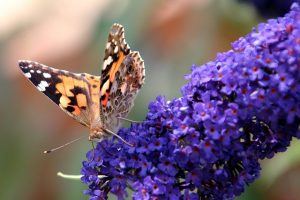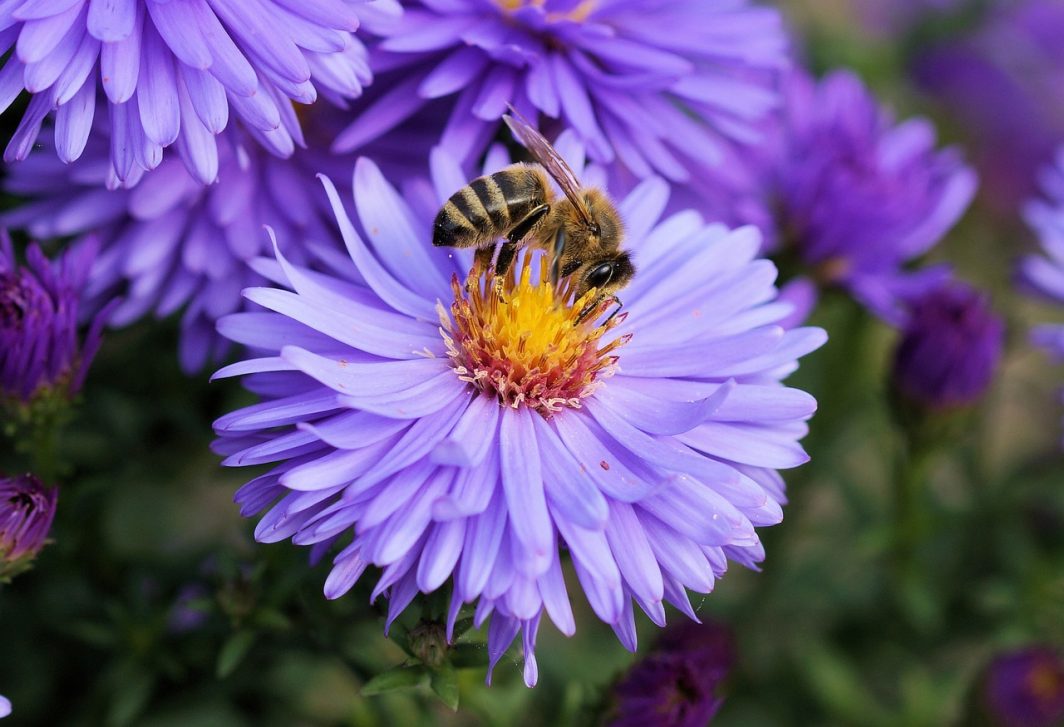If you want to attract bees into your garden, you don’t have to turn the whole garden into a mass of pollen-producing flowers (although that would look amazing!). You can easily help the bees in your area, by ensuring you have pollen and nectar rich plants for the different seasons. If you have plenty of room, you could also section off an area and plant up with native UK wildflowers – creating your very own mini wildflower meadow (and this is exactly what we do at The Grim’s Dyke).
If you’re looking for bee attractive inspiration, look no further. Here’s a list of common plants and flower the bees (and other insects) will love!
Wild Flowers
- Common honeysuckle (Lonicera periclymenum)
- Common foxglove (Digitalis purpurea)
- White clover (Trifolium repens)
- Common yarrow (Achillea Millefolium)
- Hemp agrimony (Eupatorium cannabinum)
Garden flowers
 Snowdrop (Galanthus)
Snowdrop (Galanthus)- Crocus (Crocus sativus)
- Common jasmine (Jasminum officinale)
- Sunflower (Helianthus)
- Ice plant (Sedum spectabile)
- Aster (Asteraceae)
- Pansies (Viola tricolor var. hortensis)
- Hardy fuschia (Fuschia Magellanica)
- Sweet William (Dianthus barbatus)
- Weigelia (Weigela florida)
Shrubs
- Heliotrope (Heliotropium)
- Forsythia (Forsythia)
- Lilac (Syringa)
- Rhododendron (Rhododendron ferrugineum)
- Hebe (Hebe)
- Hydrangea (Hydrangea macrophylla)

- Common broom (Genisteae)
- Viburnum (Vibiurnum)
- Buddleia (Buddleja davidii) otherwise known as the butterfly bush
- Trees and hedging:
- Magnolia (Magnolia grandiflora)
- Acer (Acer palmatum)
- Willow (Salix)
- Common laurel (Prunus laurocerasus)
- Blackthorn (Prunus spinosa)
- Crabapple (Malus)
- Leatherwood (Eucryphia lucida)
- Hawthorn (Crataegus)
- And of course, any fruit tree!
Herbs
- Chives (Allium schoenoprasum)
- Bergamot (Citrus bergamia)
- Marjoram (Origanum majorana)
- Thyme (Thymus vulgaris)
- Sage (Salvia officinalis)
- Rosemary (Rosmarinus officinalis)
- English lavender (Lavendula angustifolia)
Finally, why not provide a home for bees? If you have no intention of keeping bees yourself, why not allow a beekeeper to place a hive in your garden? Another option is to provide a nest site for the solitary bees. These
If you don’t want to keep bees yourself, but want to attract bees, why not allow a beekeeper to place a hive in your garden? Another option is to provide a nest site for the solitary bees. These
These simple nest boxes contain cardboard tubes or hollow plant stems, or predrilled blocks of wood. You can buy them from your local garden centre, and they’re ideal for solitary bees to settle down in.
It’s not just the flowers in your garden that are attractive to bees. Above all, don’t forget to have a compost heap at the end of your garden. As it’ll enable you to compost your peelings and grass clippings, and queen bumblebees may well end up nurturing their young there. Lastly, raise the cutters on your mower by a couple of centimetres. Longer grass is kinder to the bees, as it provides a safe haven for them to create burrows in the ground – it also means you don’t have to cut the grass quite so often!
Find out more about our love of nature and the walks around the hotel here.


